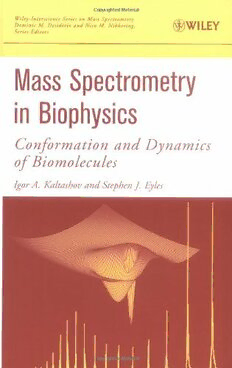
Mass Spectrometry in Biophysics : Conformation and Dynamics of Biomolecules PDF
Preview Mass Spectrometry in Biophysics : Conformation and Dynamics of Biomolecules
MASS SPECTROMETRY IN BIOPHYSICS Conformation and Dynamics of Biomolecules Igor A. Kaltashov Stephen J. Eyles University of Massachusetts at Amherst A JOHN WILEY & SONS, INC., PUBLICATION MASS SPECTROMETRY IN BIOPHYSICS WILEY-INTERSCIENCE SERIES IN MASS SPECTROMETRY Series Editors: Dominic M. Desiderio Departments ofNeurology and Biochemistry University of TennesseeHealth ScienceCenter Nico M. M. Nibbering Vrije Universiteit Amsterdam, The Netherlands John R. de Laeter ž Applications of Inorganic Mass Spectrometry MichaelKinterandNicholasE.ShermanžProteinSequencingandIdentification Using Tandem Mass Spectrometry Chhabil Dass, Principles and Practice ofBiological Mass Spectrometry Mike S. Lee ž LC/MSApplications inDrug Development Jerzy Silberring and Rolf Eckman ž Mass Spectrometry and Hyphenated Tech- niques in NeuropeptideResearch J. Wayne Rabalais ž PrinciplesandApplicationsofIonScatteringSpectrometry: Surface Chemicaland Structural Analysis Mahmoud Hamdan and Pier Giorgio Righetti ž Proteomics Today: Protein AssessmentandBiomarkersUsingMassSpectrometry,2DElectrophoresis,and Microarray Technology Igor A. Kaltashov and Stephen J. Eyles ž Mass Spectrometry in Biophysics: Conformation andDynamicsof Biomolecules MASS SPECTROMETRY IN BIOPHYSICS Conformation and Dynamics of Biomolecules Igor A. Kaltashov Stephen J. Eyles University of Massachusetts at Amherst A JOHN WILEY & SONS, INC., PUBLICATION Copyright2005byJohnWiley&Sons,Inc.Allrightsreserved. PublishedbyJohnWiley&Sons,Inc.,Hoboken,NewJersey. PublishedsimultaneouslyinCanada. Nopartofthispublicationmaybereproduced,storedinaretrievalsystem,ortransmittedin anyformorbyanymeans,electronic,mechanical,photocopying,recording,scanning,or otherwise,exceptaspermittedunderSection107or108ofthe1976UnitedStatesCopyright Act,withouteitherthepriorwrittenpermissionofthePublisher,orauthorizationthrough paymentoftheappropriateper-copyfeetotheCopyrightClearanceCenter,Inc.,222 RosewoodDrive,Danvers,MA01923,978-750-8400,fax978-646-8600,oronthewebat www.copyright.com.RequeststothePublisherforpermissionshouldbeaddressedtothe PermissionsDepartment,JohnWiley&Sons,Inc.,111RiverStreet,Hoboken,NJ07030, (201)748-6011,fax(201)748-6008. LimitofLiability/DisclaimerofWarranty:Whilethepublisherandauthorhaveusedtheir besteffortsinpreparingthisbook,theymakenorepresentationsorwarrantieswithrespectto theaccuracyorcompletenessofthecontentsofthisbookandspecificallydisclaimany impliedwarrantiesofmerchantabilityorfitnessforaparticularpurpose.Nowarrantymaybe createdorextendedbysalesrepresentativesorwrittensalesmaterials.Theadviceand strategiescontainedhereinmaynotbesuitableforyoursituation.Youshouldconsultwitha professionalwhereappropriate.Neitherthepublishernorauthorshallbeliableforanyloss ofprofitoranyothercommercialdamages,includingbutnotlimitedtospecial,incidental, consequential,orotherdamages. ForgeneralinformationonourotherproductsandservicespleasecontactourCustomerCare DepartmentwithintheU.S.at877-762-2974,outsidetheU.S.at317-572-3993or fax317-572-4002. Wileyalsopublishesitsbooksinavarietyofelectronicformats.Somecontentthatappears inprint,however,maynotbeavailableinelectronicformat. LibraryofCongressCataloging-in-PublicationData: Kaltashov,IgorA. Massspectrometryinbiophysics:conformationanddynamicsof biomolecules/IgorA.Kaltashov,StephenJ.Eyles. p.cm. Includesbibliographicalreferencesandindex. ISBN0-471-45602-0(Cloth) 1. Massspectrometry.2. Biophysics.3. Biomolecules—Spectra.I. Eyles, StephenJ.II. Title. QP519.9.M3K352005 572(cid:1).33—dc22 2004012532 PrintedintheUnitedStatesofAmerica. 10987654321 CONTENTS Preface xiii 1 General Overview of Basic Concepts in Molecular Biophysics 1 1.1. Covalent Structure of Biopolymers, 1 1.2. Noncovalent Interactions and Higher-order Structure, 10 1.2.1. Electrostatic Interaction, 10 1.2.2. Hydrogen Bonding, 11 1.2.3. Steric Clashes and Allowed Conformations of the Peptide Backbone: Secondary Structure, 11 1.2.4. Solvent–Solute Interactions, Hydrophobic Effect, Side Chain Packing, and Tertiary Structure, 14 1.2.5. Intermolecular Interactions and Association: Quaternary Structure, 18 1.3. The Protein Folding Problem, 18 1.3.1. What Is Protein Folding? 18 1.3.2. Why Is Protein Folding So Important, 19 1.3.3. What Is the Natively Folded Protein and How Do We Define a Protein Conformation? 21 1.3.4. What Are Non-native Protein Conformations? Random Coils, Molten Globules, and Folding Intermediates, 22 1.3.5. Protein Folding Pathways, 24 1.4. Protein Energy Landscapes and the Folding Problem, 25 1.4.1. Protein Conformational Ensembles and Energy Landscapes: Enthalpic and Entropic Considerations, 25 v vi CONTENTS 1.4.2. Equilibrium and Kinetic Intermediates on the Energy Landscape, 28 1.5. Protein Dynamics and Function, 30 1.5.1. Limitations of the Structure–Function Paradigm, 30 1.5.2. Protein Dynamics Under Native Conditions, 31 1.5.3. Biomolecular Dynamics and Binding from the Energy Landscape Perspective, 34 1.5.4. Energy Landscapes Within a Broader Context of Nonlinear Dynamics: Information Flow and Fitness Landscapes, 37 References, 38 2 Overview of “Traditional” Experimental Arsenal to Study Biomolecular Structure and Dynamics 45 2.1. X-Ray Crystallography, 45 2.1.1. Fundamentals, 45 2.1.2. Crystal Structures at Atomic and Ultrahigh Resolution, 47 2.1.3. Crystal Structures of Membrane Proteins, 48 2.1.4. Protein Dynamics and X-Ray Diffraction, 48 2.2. Solution Scattering Techniques, 49 2.2.1. Static and Dynamic Light Scattering, 49 2.2.2. Small-Angle X-Ray Scattering, 50 2.2.3. Cryo-Electron Microscopy, 51 2.2.4. Neutron Scattering, 53 2.3. NMR Spectroscopy, 53 2.3.1. Heteronuclear NMR, 56 2.3.2. Hydrogen Exchange by NMR, 56 2.4. Other Spectroscopic Techniques, 59 2.4.1. Cumulative Measurements of Higher Order Structure: Circular Dichroism, 59 2.4.2. Vibrational Spectroscopy, 64 2.4.3. Fluorescence: Monitoring Specific Dynamic Events, 68 2.5. Other Biophysical Methods to Study Macromolecular Interactions and Dynamics, 71 2.5.1. Calorimetric Methods, 71 2.5.2. Analytical Ultracentrifugation, 74 2.5.3. Surface Plasmon Resonance, 79 2.5.4. Gel Filtration, 80 2.5.5. Gel Electrophoresis, 80 References, 81 3 Overview of Biological Mass Spectrometry 87 3.1. Basic Principles of Mass Spectrometry, 87 3.1.1. Stable Isotopes and Isotopic Distributions, 89 3.1.2. Macromolecular Mass: Terms and Definitions, 96 CONTENTS vii 3.2. Methods of Producing Biomolecular Ions, 97 3.2.1. Macromolecular Ion Desorption Techniques: General Considerations, 97 3.2.2. Electrospray Ionization, 97 3.2.3. Matrix Assisted Laser Desorption/Ionization, 102 3.3. Mass Analysis, 107 3.3.1. General Considerations: m/z Range and Mass Discrimination, Mass Resolution, Duty Cycle, Data Acquisition Rate, 107 3.3.2. Mass Spectrometry Combined with Separation Methods, 109 3.4. Tandem Mass Spectrometry, 111 3.4.1. Basic Principles of Tandem Mass Spectrometry, 113 3.4.2. Collision-Induced Dissociation: Collision Energy, Ion Activation Rate, Dissociation of Large Biomolecular Ions, 114 3.4.3. Other Fragmentation Techniques: Electron-Capture Dissociation, Photoradiation-Induced Dissociation, Surface-Induced Dissociation, 116 3.4.4. Ion–Molecule Reactions in the Gas Phase: Internal Rearrangement, Charge Transfer, 118 3.5. Brief Overview of Common Mass Analyzers, 118 3.5.1. Mass Analyzer as an Ion Dispersion Device: Magnetic Sector MS, 119 3.5.2. Temporal Ion Dispersion: Time-of-Flight MS, 122 3.5.3. Mass Analyzer as an Ion Filter, 124 3.5.4. Mass Analyzer as an Ion Storing Device: Quadrupole (Paul) Ion Trap, 127 3.5.5. Mass Analyzer as an Ion Storing Device: FT ICR MS, 130 3.5.6. Hybrid Mass Spectrometers, 133 References, 134 4 Mass Spectrometry-Based Approaches to Study Biomolecular Higher-Order Structure 143 4.1. Biomolecular Topography: Contact and Proximity Maps via Chemical Cross-Linking, 144 4.2. Mapping Solvent-Exposed Regions: Footprinting Methods, 157 4.2.1. Selective Chemical Labeling, 157 4.2.2. Nonspecific Chemical Labeling, 161 4.2.3. Hydrogen/Deuterium Exchange, 163 4.3. Emerging Low-Resolution Methods: Zero-Interference Approaches, 167 4.3.1. Stoichiometry of Protein Assemblies and Topology of the Interface Regions: Controlled Dissociation of Noncovalent Complexes, 167
